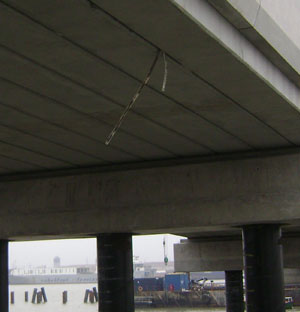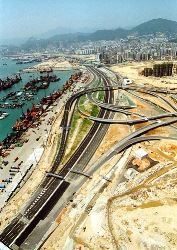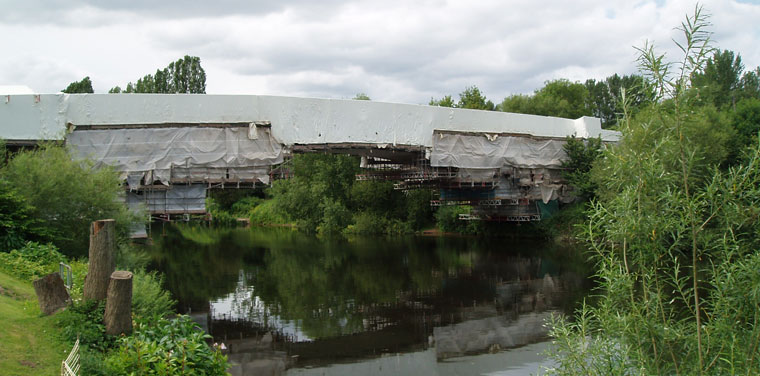(Image above) Concrete cover was successfully reinstated on Holt Fleet Bridge in Worcestershire
Chris Lloyd of Flexcrete Technologies gives detail of the effects that deterioration can have on the design life of bridges and the concrete coatings that can protect and reinstate cover.
and Bridges are amongst the most critical structures to protect against low concrete cover. The damaging effects of chlorides from de-icing salts and onerous environments, as well as carbonation attack, can all drastically reduce the design life of structures, leading to expensive maintenance bills and at worst, force premature demolition.
The depth and quality of the cover concrete is absolutely vital, as the relatively thin layer of concrete protects the reinforcing steel from corrosion by maintaining an alkali environment and preventing the ingress of chloride ions and all the fuels for corrosion. All too often precast elements are rejected during quality control low cover checks on-site and it becomes necessary for localised sections of new construction to be re-cast.
Causes of Low Cover
Low cover can be caused by any number of factors. Today’s complex designs frequently lead to difficulties on-site, whereby the sheer density of reinforcement provides supreme challenges for contractors. In such instances, insufficient consideration is given to the mix design of the concrete to enable it to be poured into confined spaces with congested steel. Shoddy workmanship often leads to low cover problems. Errors may occur when formwork is fixed, inadequate spacers may be used or reinforcement may become displaced when concrete is poured and compacted.
As soon as low concrete cover has been identified, it is important to take swift action, otherwise the lack of protection to the re-bars will lead to premature de-passivation of the steel and subsequent corrosion. Inadequate concrete cover will not only speed up the damaging effects of carbonation but also allow even more rapid ingress of chlorides, moisture and oxygen.
Once low cover has been identified the Engineer can determine the implications on the design in terms of structural and durability requirements for the particular exposure conditions and consider possible remedial measures.
Various options may be open. These could range from the drastic and costly measures of demolishing sections that fail to meet the required specifications, or partial recasting with new concrete. This involves removal of the concrete back to behind the level of reinforcement using high pressure water lancing, repositioning the formwork to achieve the desired cover and recasting the concrete. However, it can often prove difficult to access the area to carry out the remedial work.
Protective Concrete Coatings
A more practical and cost-effective means of reinstating cover on bridges is to apply a protective coating. There are many different products available on the market and it is important to assess factors such as substrate compatibility, life span and the film thickness required to provide the necessary cover, not to mention successful track record of use on similar structures and independent approvals such as CE Marking in accordance with BS EN 1504.
One product which is frequently specified for reinstating effective cover on precast and in-situ reinforced concrete is Cementitious Coating 851 – a waterborne, cementitious modified polymer coating. Independent tests show that a 2mm coating of Cementitious Coating 851 is equivalent to 100mm of good quality concrete cover, as well as providing a complete barrier to water under 10 bar pressure. Being cement based, it chemically reacts with the substrate to form an integral part and will have a design life equivalent to that of the concrete to which it is applied. 851 can be applied to green concrete by brush or spray techniques, exhibits minimal hazard during application and is non-toxic when cured.
Preventing Chloride Ingress
The ability to combat chloride ingress is a critical factor on bridges and the VINCI Construction Technology Centre has assessed the chloride ion diffusion of Cementitious Coating 851 for the past 24 years, and to date, no steady state of flux of chloride ions has been detected, whereas the control concrete achieved this in just 28 days.
Cases in Action
The benefits of such technology have been clearly demonstrated on a number of bridge and highway structures both in the UK and further afield. For instance, Holt Fleet Bridge – a 200-year old, Grade II listed structure in Worcestershire – was protected with Cementitious Coating 851 on the underside of the structure to extend its lifespan. Egginton Bridge in Derbyshire was also protected with 851 in 1989 as a result of severe corrosion of the reinforcement due to carbonation, chloride attack and water ingress. A survey carried out by Mott MacDonald almost 15 years later revealed that not only had the chloride ingress and carbonation been prevented, but the concrete had also re-alkalised, affording greater corrosion protection to the steel whilst the coating continued to provide an effective barrier to moisture, chloride ions and carbon dioxide.

Designers have also specified Cementitious Coating 851 to increase durability on new construction. For example, when a link bridge was constructed at Belvedere Riverside Energy from Waste (EFW) facility in South East London, the consultants specified 851 to protect the structure from chloride ingress, thereby ensuring the design life of the structure was achieved. Enhancement of 35mm cover to 91 precast beams was required and a 2mm coating of 851 ensured the structure was a barrier to both chloride and water ingress. In order to blend in, the colour of 851 was matched to that of the parent concrete.
(Image left) A cementitious coating was specified to ensure the design life of a new link bridge at Belvedere Riverside Energy from Waste (EFW) facility in South East London

On a global basis, Cementitious Coating 851 has also been used on many structures worldwide, including West Kowloon Expressway – a four kilometre stretch of highway which carries traffic out to Hong Kong International Airport. The Northern section is carried on a viaduct constructed from precast concrete segments and during construction, low cover was detected on a number of segments. Cementitious Coating 851 was approved as an economic and practical solution to enhance effective cover and the contractor blended white and grey shades of 851 to provide a colour matched solution which could be used in discreet patches.
(Image right) A cementitious coating was used as an innovative engineering solution to reinstate cover on sections of the West Kowloon Expressway in Hong Kong
High performance cementitious coatings present an ideal solution to non-conformance with specification. Not only do they reinstate cover, they also provide structures with additional protection against freeze/thaw cycles, de-icing salts, water and chloride ion penetration, thus ensuring that the life span of the structure is both achieved and extended.



